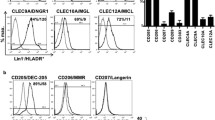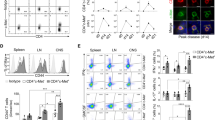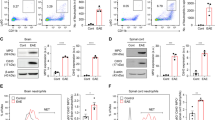Abstract
Excessive infiltration of leukocytes and the elaboration of inflammatory cytokines are believed to be responsible for the observed damage to neurons and oligodendrocytes during multiple sclerosis (MS). Blocking adhesion molecules or preventing the effects of chemotactic mediators such as chemokines can be exploited to prevent immune cell recruitment to inflamed tissues. An anti-α4 integrin antibody (anti-VLA-4mAb/natalizumab (Tysabri®)) has been used as a treatment for MS and reduces leukocyte influx into the brain. In patients, anti-VLA-4 reduces relapses and disability progression. However, its mechanism of action in the brain is not completely understood. The anti-VLA-4mAb was demonstrated to mobilize hematopoietic progenitor cells. Interestingly, the chemokine SDF-1/CXCL12 and its receptor CXCR4 are also key factors regulating the migration of hematopoietic stem cells. Moreover, studies have revealed a crosstalk between SDF-1/CXCR4 and VLA-4 signaling in regulating cell migration. In this study, we address the effects of anti-VLA-4 on chemokine signaling in the brain during MS. We assessed the ability of anti-VLA-4 to regulate Experimental Autoimmune Encephalomyelitis (EAE) and chemokine/receptor signaling. Preclinical administration of anti-VLA-4 delayed clinical signs of EAE. We found that anti-VLA-4 treatment reduced chemokine expression. In order to further explore the interaction of anti-VLA-4 with chemokine/receptor signaling we used dual color transgenic mice. After EAE induction, the expression of both SDF-1/CXCL12 and CXCR4 receptor was upregulated, treatment with anti-VLA-4 inhibited this effect. The effects of anti-VLA-4 on chemokine signaling in the CNS may be of importance when considering its mechanism of action and understanding the pathogenesis of EAE.




Similar content being viewed by others
References
Banisadr G, Frederick TJ, Freitag C, Ren D, Jung H, Miller SD, Miller RJ (2011) The role of CXCR4 signaling in the migration of transplanted oligodendrocyte progenitors into the cerebral white matter. Neurobiology of Disease 44:19–27
Bhattacharyya BJ, Banisadr G, Jung H, Ren D, Cronshaw DG, Zou Y, Miller RJ (2008) The chemokine stromal cell-derived factor-1 regulates GABAergic inputs to neural progenitors in the postnatal dentate gyrus. J Neurosci 28:6720–6730
Bitsch A, Schuchardt J, Bunkowski S, Kuhlmann T, Bruck W (2000) Acute axonal injury in multiple sclerosis. Correlation with demyelination and inflammation. Brain 123(6):1174–1183
Bonig H, Watts KL, Chang KH, Kiem HP, Papayannopoulou T (2009) Concurrent blockade of alpha4-integrin and CXCR4 in hematopoietic stem/progenitor cell mobilization. Stem Cells 27(4):836–837
Frohman EM, Racke MK, Raine CS (2006) Multiple sclerosis–the plaque and its pathogenesis. N Engl J Med 354(9):942–955
Fuller KG, Olson JK, Howard LM, Croxford JL, Miller SD (2004) Mouse models of multiple sclerosis: experimental autoimmune encephalomyelitis and Theiler’s virus-induced demyelinating disease. Methods Mol Med 102:339–361
Glabinski AR, Tani M, Strieter RM, Tuohy VK, Ransohoff RM (1997) Synchronous synthesis of alpha- and beta-chemokines by cells of diverse lineage in the central nervous system of mice with relapses of chronic experimental autoimmune encephalomyelitis. Am J Pathol 150(2):617–630
Kennedy KJ, Karpus WJ (1999) Role of chemokines in the regulation of Th1/Th2 and autoimmune encephalomyelitis. J Clin Immunol 19(5):273–279
McCandless EE, Piccio L, Woerner BM, Schmidt RE, Rubin JB, Cross AH, Klein RS (2008) Pathological expression of CXCL12 at the blood–brain barrier correlates with severity of multiple sclerosis. Am J Pathol 172:799–808
Menn B, Garcia-Verdugo JM, Yaschine C, Gonzalez-Perez O, Rowitch D, Alvarez-Buylla A (2006) Origin of oligodendrocytes in the subventricular zone of the adult brain. J Neurosci 26:7907–7918
Nagasawa T, Hirota S, Tachibana K, Takakura N, Nishikawa S, Kitamura Y, Yoshida N, Kikutani H, Kishimoto T (1996) Defects of B-cell lymphopoiesis and bone-marrow myelopoiesis in mice lacking the CXC chemokine PBSF/SDF-1. Nature 382(6592):635–638
Nait-Oumesmar B, Picard-Riera N, Kerninon C, Decker L, Seilhean D, Hoglinger GU, Hirsch EC, Reynolds R, Baron-Van EA (2007) Activation of the subventricular zone in multiple sclerosis: evidence for early glial progenitors. Proc Natl Acad Sci U S A 104:4694–4699
Ngo HT, Leleu X, Lee J, Jia X, Melhem M, Runnels J, Moreau AS, Burwick N, Azab AK, Roccaro A, Azab F, Sacco A, Farag M, Sackstein R, Ghobrial IM (2008) SDF-1/CXCR4 and VLA-4 interaction regulates homing in Waldenstrom macroglobulinemia. Blood 112(1):150–158
Petty JM, Lenox CC, Weiss DJ, Poynter ME, Suratt BT (2009) Crosstalk between CXCR4/stromal derived factor-1 and VLA-4/VCAM-1 pathways regulates neutrophil retention in the bone marrow. J Immunol 182(1):604–612
Pluchino S, Martino G (2005) The therapeutic use of stem cells for myelin repair in autoimmune demyelinating disorders. J Neurol Sci 233:117–119
Tran PB, Banisadr G, Ren D, Chenn A, Miller RJ (2007) Chemokine receptor expression by neural progenitor cells in neurogenic regions of mouse brain. J Comp Neurol 500(6):1007–1033
Trapp BD, Peterson J, Ransohoff RM, Rudick R, Mörk S, Bö L (1998) Axonal transection in the lesions of multiple sclerosis. N Engl J Med 338(5):278–285
Zohren F, Toutzaris D, Klärner V, Hartung HP, Kieseier B, Haas R (2008) The monoclonal anti-VLA-4 antibody natalizumab mobilizes CD34+ hematopoietic progenitor cells in humans. Blood 111:3893–3895
Acknowledgments
This work was supported by funding from Biogen Idec and the NIH.
Conflict of interest
Authors have no conflict of interest to disclose.
Author information
Authors and Affiliations
Corresponding author
Rights and permissions
About this article
Cite this article
Banisadr, G., Schwartz, S.R., Podojil, J.R. et al. Integrin/Chemokine Receptor Interactions in the Pathogenesis of Experimental Autoimmune Encephalomyelitis. J Neuroimmune Pharmacol 9, 438–445 (2014). https://doi.org/10.1007/s11481-014-9521-9
Received:
Accepted:
Published:
Issue Date:
DOI: https://doi.org/10.1007/s11481-014-9521-9




